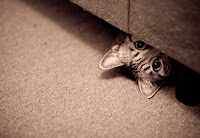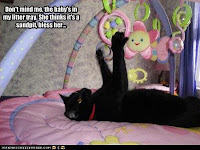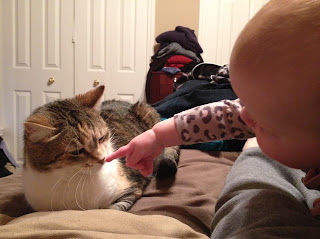When medical issues have been ruled out, and husbandry issues have been resolved, if a cat is still eliminating outside the box, it is likely to be due to a behavioral issue. Unfortunately, while litterbox environment and medical issues are relatively straightforward to address, behavioral issues can be complicated.
 |
| New furniture can stress your cat. |
For example:
If your cat eliminates inappropriately when you go on vacation, you may find that you can curb the behavior by boarding the cat while you are gone, hiring an in-home sitter versus having a neighbor stop by the house once or twice daily, or by taking your cat with you. Discussions with your veterinarian may even lead to recommendations for medicinal therapy while you are gone to alleviate anxiety.
If you are planning on getting a new pet or having a baby, preparing your cat for the new addition may head off any potential behavioral issues. Also, making sure to introduce the new pet to the resident cat on a gradual basis will help lessen the stress your cat may feel about a new addition.
Sometimes inappropriate elimination can become so ingrained in a cat that even once the stress has been removed, the behavior continues. If this is the case it is a good idea to seek advice from your veterinarian as to how to re-train your cat.
 |
| Spraying posture - standing near a vertical surface, tail erect |
It is most commonly the male cat that sprays, but it is not unheard of for female cats to spray, also. Spaying and neutering your cats will help prevent this issue in most cats, as the lack of male and female hormones will dull the desire to mark and maintain territory, and the need to advertise sexual availability – which are the primary reasons that cats urine mark. However, about 10% of neutered males and 5% of neutered females also spray. In households with more than seven cats, the likelihood of spraying is high.
 |
| Coleus canina flower |
Cats also hate the smell of the herb rue. It has beautiful blue-tone leaves and tiny yellow flowers. Cats are also usually deterred by the smell of citrus, so placing orange or lemon peel in your yard may help deter strays. Similarly, coffee grounds, blood meal, cayenne pepper, lavender oil, lemon grass oil, citronella oil, peppermint oil and eucalyptus oil can be used near areas where outdoor cats like to hang out.
Avoid feeding birds or squirrels in your yard if your cat is bothered by stray cats.
Motion detectors that trigger sprinklers can be used to deter them from coming onto your property. Additionally, you can discourage your cat from looking outside by closing blinds or shades, or making the windowsill inaccessible. Double-sided tape, tin foil or strips of carpet runner on the sill may also deter your cat.
Spraying can also result from territorial disputes between cats in the same household. They may need to be separated and reintroduced slowly, using food treats to reward and encourage peaceful behavior. This re-introduction can successfully develop good relations between cats in some cases, even if the spraying has been going on for a long time.
 While the presence of other cats, lack of access to prey species or sexual maturity are the most common reasons that cats perform spraying behavior, other causes can be new or unfamiliar scents in the home (such as new furniture, or digging out the Christmas tree from the attic or bringing a live tree into the home) or frustration due to lack of mental stimulation. Often, spraying new items with a pheromone called Feliway can help lessen your cat’s desire to mark. This product mimics the scent of cat cheek gland secretions. Many cats will not spray on areas that have this scent. Increasing the amount of playtime for an under-stimulated cat may help ease frustration.
While the presence of other cats, lack of access to prey species or sexual maturity are the most common reasons that cats perform spraying behavior, other causes can be new or unfamiliar scents in the home (such as new furniture, or digging out the Christmas tree from the attic or bringing a live tree into the home) or frustration due to lack of mental stimulation. Often, spraying new items with a pheromone called Feliway can help lessen your cat’s desire to mark. This product mimics the scent of cat cheek gland secretions. Many cats will not spray on areas that have this scent. Increasing the amount of playtime for an under-stimulated cat may help ease frustration.
Behavior-related elimination issues are often addressed with anti-anxiety medications, such as Prozac (fluoxetine), BuSpar (buspirone), Elavil (amitriptyline), and Clomicalm (clomipramine). Anxitane is a neutraceutical (nutritional therapy) supplement of L-Theanine that has also been shown to aid in decreasing anxiety in cats. Medications are useful in helping to decrease behavioral inappropriate elimination, but they should always be used in conjunction with changes to the home or other environmental changes with the goal of hopefully weaning the cat off the medication, if possible.
More information about inappropriate elimination: Lovin' the Litterbox: Husbandry Reasons Why Your Cat May Not Use the Litterbox
Kidneys and Crystals and Stones, Oh, My! Medical Reasons Why Your Cat May Not Use the Litterbox
Breaking the Cycle of Smell: How to Stop Habitual Elimination Problems







































